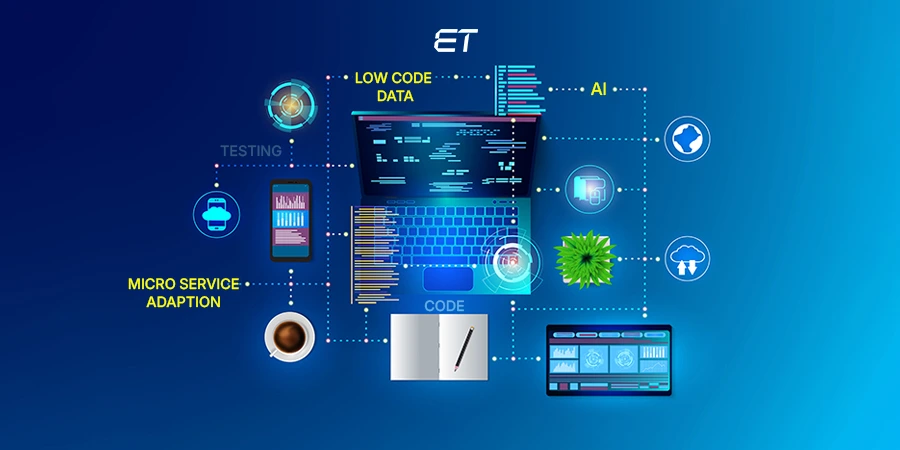
Best Low Code Development Platforms- Detailed Guide 2025
Low code development platforms have become game-changers as we traverse the rapidly changing world of software development, enabling companies to produce apps quickly and effectively. Due to their capacity to democratize software development and hasten digital transformation, these low code platforms will be in high demand in 2025 and beyond.
According to Gartner, over 50% of all medium- and large-sized businesses are expected to adopt a low code development platform as one of their primary application platforms by 2025.
Moreover, as per other reports
- It is expected that by 2030, the low-code development business will bring in $187 billion. (Source)
- By 2025, low-code tools will be used for more than 65% of application development. (Source)
- Over 500 million apps and services will be created via cloud-native techniques by 2023. (Source)
Low code app development platforms have become game-changers as we traverse the rapidly changing world of software development, enabling companies to produce apps quickly and effectively. Due to their capacity to democratize software development and hasten digital transformation, these platforms will be in high demand in 2023 and beyond.
OutSystems is one of the low code development platforms examples. It enables users to develop applications with minimal manual coding, utilizing visual interfaces and pre-built modules.
The low code app development platforms offer a graphical user interface for programming, enabling quick code generation and reducing the time and labor needed for traditional programming.
Low code development platforms are the future due to their ability to accelerate software development and empower dedicated developers. With intuitive visual interfaces and pre-built components, low-code platforms enable users to create applications with minimal coding expertise.
Using low code platforms has several advantages, including
- Better Customer Experience
- Improved Business Agility
- Speed up App Development Activities
- Keep a Check on Shadow IT
- Encourage Collaboration
- Increased Analytical Capacity
Low-code front-end development can be beneficial when aiming for rapid application development, increased productivity, and easier collaboration between business and IT teams.
Here, we’ve listed the top low-code development platforms for 2025 that can aid companies in implementing digital changes more quickly and effectively.
Without further delay, let’s dive into all of them!
Experience the future of development with low-code platforms. We’ll guide you to smarter solutions for your needs!
What are Low-code Platforms?
Low code app development platforms are software development tools that allow users to build applications with minimal hand-coding and traditional programming. These platforms consist of pre-built templates, drag-and-drop components, and visual interfaces. Therefore, users with different degrees of technical proficiency may quickly construct robust applications.
Professional developers may build applications more quickly by using low-code and no-code modular techniques, eliminating the need to write line-by-line code. Moreover, non-software professionals, such as office managers, small business owners, and business analysts, can create and test applications using these platforms. These folks don’t need to know anything about machine code, conventional programming languages, or the development processes behind the platform’s programmable components to create apps.
How to Choose the Best Low Code Development Platforms?
When choosing the top low code development platforms, consider the following factors to ensure they align with your organization’s needs and objectives. By carefully evaluating these factors, you can select low-code platforms that fits your organization’s needs and enables rapid application development with minimal coding effort.
-
Business Requirements
Identify your organization’s specific needs and objectives. Determine the type of applications you intend to develop, such as mobile apps, web applications, or business process automation solutions.
-
Scalability
Ensure the platform can accommodate your organization’s growth and handle increasing complexity as your application portfolio expands.
-
Customization
Evaluate the platform’s flexibility in customization to meet unique business requirements and integrate with existing systems and databases.
-
Security
Prioritize platforms with robust security features, including data encryption, role-based access controls, and compliance with industry regulations like GDPR or HIPAA.
-
Vendor Support and Community
Consider the level of support the vendor provides, including documentation, training resources, and customer service. Additionally, assess the size and activity of the platform’s user community for access to knowledge sharing and peer support.
-
Cost
Compare pricing models, including licensing fees, subscription plans, and additional charges for premium features or support services, to ensure the platform aligns with your budget constraints.
Speaking of low code platforms, you must be excited to know all about Power Apps. If the answer is yes,
Top 10 Open-Source Low-code Development Platforms
Find the best low code development platforms based on user reviews.
| Low Code Development Platforms | Platforms | Free Trial | Starting Price |
 |
Cloud-based, Windows, Mac, Linux, UNIX, Solaris etc. | Available | Free |
 |
Cloud-based, iOS, Android, and PWA. | Available | $25per user per month, billed annually |
 |
Web-based, Windows, Linux, Android, iPhone, & Windows Phone. | Community Version is Free | $1875/month. |
 |
Cloud-based solution | Free Plan | $18000/year |
 |
Cloud-based solution. Supports iOS & Android devices also. | Available | $9 per user per month. |
 |
Cloud based solutions | Not Available | $25,000 USD per year |
 |
web browsers, Windows, iOS, and Android platforms | Available | $5 per user per month |
 |
web browsers and mobile devices, including iOS and Android platforms | Available | $19 per user per month |
 |
web browsers and mobile devices, including iOS and Android platforms | Available | $30 per user per month |
 |
Web-based, Windows, Mac. | Available | $25 per user per month |
1. Appian
First in our list of low code development platforms is Appian. One of the best low code development platforms that rapidly empowers businesses to develop, deploy, and maintain powerful enterprise applications. Abstracting complex coding tasks enable users to build applications visually using drag-and-drop components and pre-built templates. With seamless integration capabilities and process automation features, Appian accelerates digital transformation and enhances agility.
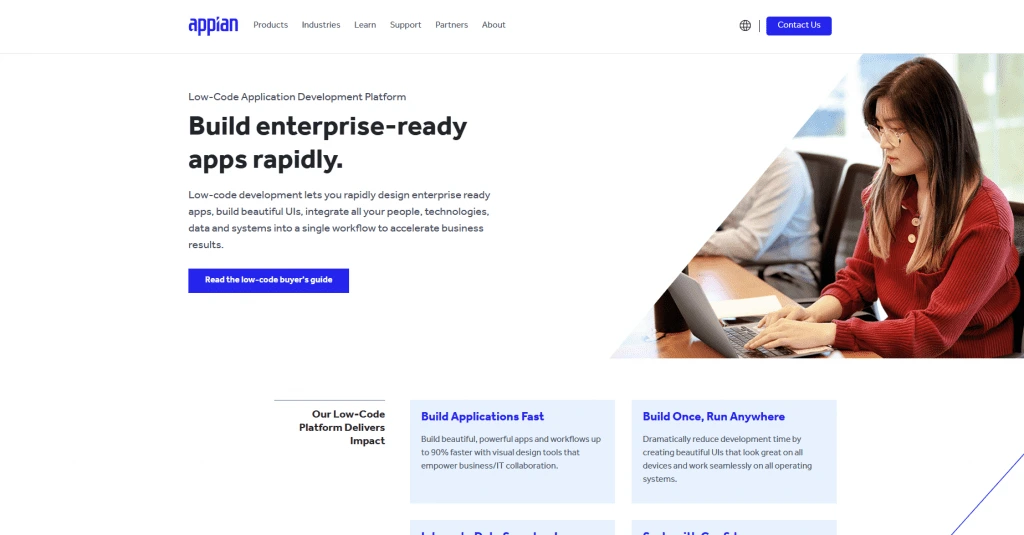
In 2022 Appian was declared a leader in SPARK Matrix, a LCAD (low code application development) for professional developers.
Moreover, as per leading front-end development companies, everything you require to design, automate, and optimize even the most complicated processes is included in the Appian AI-Powered Process Platform. The most innovative companies in the world depend on Appian to streamline workflows, synchronize data, and simplify operations for faster growth and enhanced client experiences.
Appian Pricing:
- Free plan with limited functionality.
- Pricing starts at $75 per user/month (minimum charge for 100 users)
Appian Rating:

Target Group
Industries such as finance, healthcare, government, and more
Use Case
- Business process automation for improved efficiency
- Rapid application development for faster time-to-market
- Customer relationship management (CRM) solutions
- Human resources (HR) workflows and onboarding processes
- Financial services applications, such as loan processing
- Healthcare solutiotargetns, including patient management systems
- Government agencies for citizen services and regulatory compliance.
Appian Features:
- Drag-and-drop interface for visual development
- Process automation for streamlined workflows
- Seamless integration with existing systems
- Mobile and cross-device support
- Low-code data modeling for easy database management
- Rules engine for defining and enforcing business rules
- AI and machine learning capabilities for advanced analytics
- Real-time reporting and analytics dashboards
- Strong emphasis on security and compliance
- Collaboration tools for teamwork
- App marketplace with pre-built applications and templates
- Version control for efficient management of changes and updates.
Appian Pros & Cons:
| Pros | Cons |
| Seamless Integration Capabilities | Costly licensing and implementation |
| Real-time Reporting and Analytics | Limited customization compared to code |
| AI and Machine Learning Integration | Dependency on third-party integrations |
| Mobile and Cross-Device Support | Complexity in managing larger projects |
| Collaboration and Teamwork Features | Limited offline capabilities |
2. Zoho Creator

Next in our list of low code development platforms is Zoho Creator. It is a powerful low code development platform that empowers businesses to create custom applications without extensive coding knowledge. Top-rated custom web application development companies are familiar with Zoho due to its robust customer relationship management (CRM) solution. Zoho Creator is an easy-to-use, no-code or low-code creation platform with superior visual capabilities. The platform is versatile and user-friendly, combining various functionalities with a visually pleasing user interface.
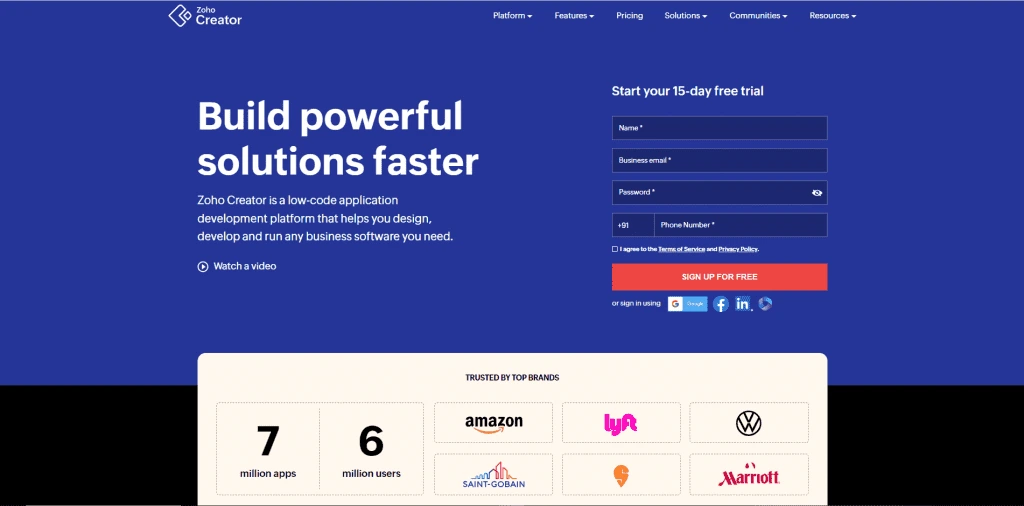
This low code application development platform offers various useful data reports and role-based control tools to keep your organization running smoothly. It supports all Android and iOS devices and operates on a drag-and-drop model. It may be integrated with well-known business apps and platforms like PayPal and Zapier to transform business logic into simplified workflows.
Zoho Creator Pricing:
Free trial up to a few attempts with limited functionality
Pricing: It comes with three attractive pricing plans
- Standard- $6/user/monthly billed annually
- Professional- $15/user/monthly billed annually
- Enterprise- $18/user/monthly billed annually
Zoho Creator Rating:

Target Group
Custom business applications for various industries like finance, healthcare, and retail
Use Case
- Data collection forms and surveys for data gathering and analysis
- Project management and task tracking applications
- Inventory management and order processing systems
- Customer relationship management (CRM) solutions
- Employee onboarding and HR processes
- Field service management and tracking applications
- Event management and registration systems
- Online database applications for data organization.
Zoho Creator Features:
- Form builder for data collection
- Integration with various databases and third-party apps
- Mobile app support for on-the-go access
- Reports and dashboards for real-time analytics
- Customizable user interfaces and themes
- Deploy multi-device apps to the platform of your choice
- Security features to protect sensitive data
- Scalability for growing businesses
- Pre-built application templates for quick deployment
- AI-powered functionalities for advanced insights and automation.
Zoho Creator Pros & Cons:
| Pros | Cons |
| Easy-to-use Visual Interface | Limited Customization |
| Pre-built Templates for Efficiency | Advanced Features Requires Technical Expertise |
| Integration With Zoho Products | Limited third-party integrations |
| Affordable Pricing Options | Dependency on Zoho Ecosystem |
| Scalability for Growing Business | Limited Offline Capabilities |
3. Mendix

Mendix is an open-source low code development platform that includes many app development tools. You can develop project management environments, process automation tools, B2C mobile applications, and B2B web portals. Private cloud, public cloud, and on-premises deployment are all options. Along with the Enterprise edition, it offers the features of automated backups and horizontal scaling.
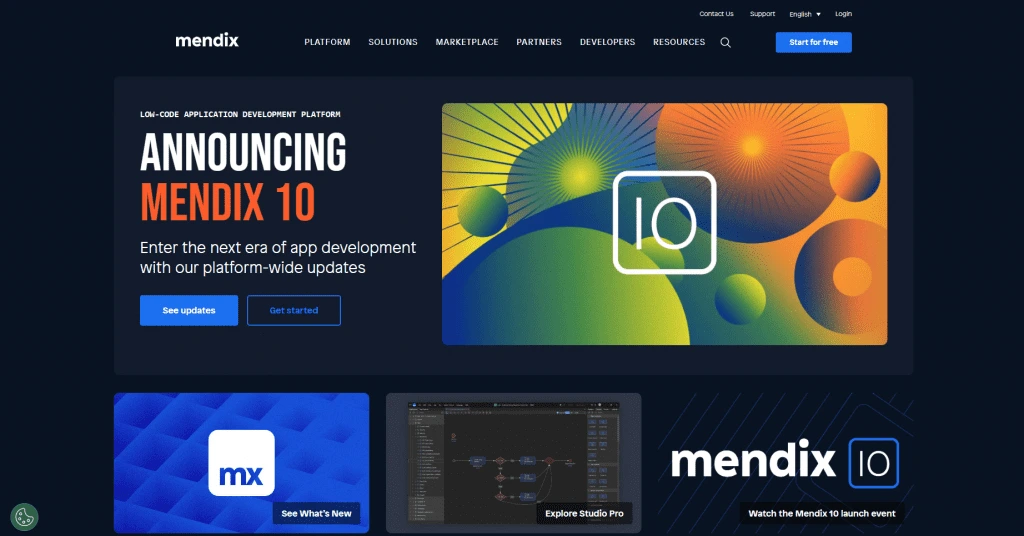
This low code development platform offers a wide range of data sources, including databases, SDKs, REST, and GraphQL APIs. Reusable components, automated development backup (which prevents losing code clusters), and a visual drag-and-drop interface make the development process extraordinarily streamlined and simple. A compelling IDE (Integrated Development Environment) exists for larger teams for more productive integration and collaboration activities.
Mendix Pricing:
- Free trial available
- Basic plan- €50/Month
- Standard Plan– €800/Month
Rating

Target Group
Business analysts and dedicated software development teams.
Use Case
- Custom CRM and customer engagement solutions
- Supply chain and logistics management applications
- IoT and connected devices integration
- HR and employee onboarding systems
- Native B2C mobile applications
- Financial services applications for banking and insurance
- Field service management and asset tracking
- Regulatory compliance and data governance solutions
Mendix Features:
- Intuitive visual development environment for quick app creation
- Extensive library of pre-built UI components and templates
- Seamless integration with various data sources and APIs
- Automated testing and deployment options for efficiency
- Model-driven development approach for simplified coding
- Built-in version control and rollback options
- Scalable architecture to accommodate growing needs
- AI and machine learning integration for enhanced functionality
Mendix Pros & Cons:
| Pros | Cons |
| Agile Project Management | Steeper Learning Curve for Beginners |
| Intuitive Visual Development | Support Responsiveness can Vary |
| Reusable Components | Reliance on third-party integrations |
| Cloud Native Deployment & Hosting | Performance Issue with Large Applications |
| Cross-Functional Analytics | Costly for Enterprise-Level Usage |
Mendix vs Power Apps: The showdown you can’t miss. Discover the platform that suits your business!
4. OutSystems

Next in our list of low code development platforms is Outsystem. An Android application development low code platform enabling businesses to create unique applications quickly and effectively. The model-driven platform OutSystems uses makes creating applications without writing code simple. OutSystems constantly introduces new features and uses the most recent cloud and mobile technology. It has cross-platform programs, a drag-and-drop user interface, and data models enabling full-stack development.
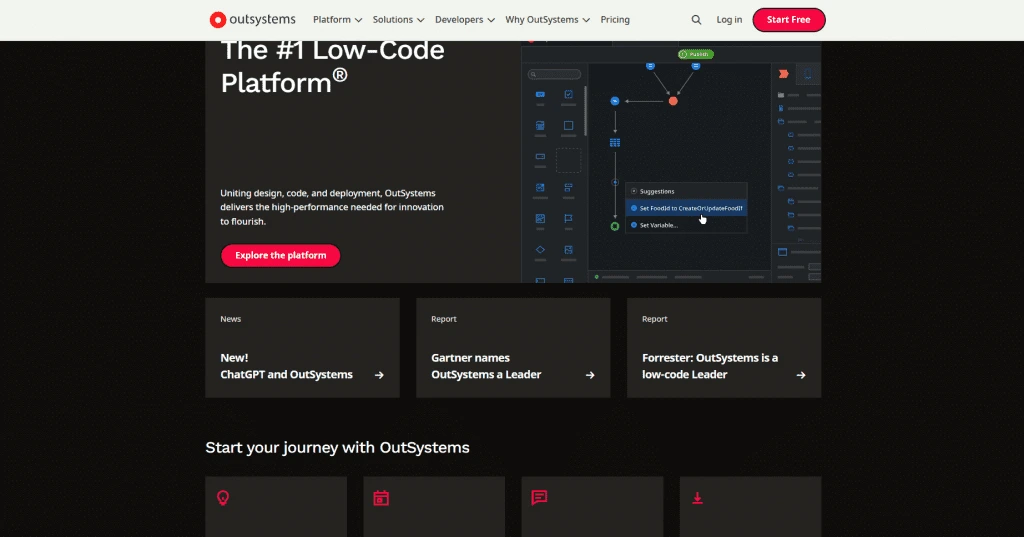
With the help of this platform you may simply develop custom web applications that support a variety of business use cases with a clear and straightforward user interface. OutSystems facilitates the creation of APIs for further flexibility and integration without difficulty with your current systems. You can easily build, launch, manage, and update your enterprise mobile and web apps using the platform created to provide you with everything you need.
OutSystems Pricing:
- Single Apps- First attempt is free
- Multiple Apps- Starts at $1513/ per month, billed annually
- Large App Portfolio- Get a quote
Rating

Target Group
OutSystems’ low-code platform caters to various industries, including finance, healthcare, manufacturing, retail, and government
Use Case
- Legacy system modernization and integration projects
- Customer-facing applications for improved user experiences
- Business process management apps
- Supply chain management and inventory control solutions
- Human resources and employee management systems
- Financial services applications, including banking and insurance
- Field service management and asset tracking
- Portfolio management tools.
OutSystems Features:
- Intuitive visual development environment for rapid app creation
- Pre-built templates and UI components for efficient design
- Built-in security measures and compliance features
- Your apps will be deployed without errors, whether they are in the cloud or on-premises.
- Robust version control and deployment options
- Offline capabilities for disconnected environments
- Extensive library of reusable modules and connectors
- Real-time monitoring and analytics for performance insights.
OutSystems Pros & Cons:
| Pros | Cons |
| Intuitive Visual Development | Costly Licensing, Especially for Large-Scale Use |
| Entirely Scalable Through APIs | Limited Customization Possible |
| AI-Powered Automation and Real-Time Analytics | Dependency on third-party integrations |
| Completely Secured Functionality | Performance Issue with Large Applications |
| DevOps Automation. | Based on Vendor Policies Support Responsiveness Vary |
5. Kissflow

OrangeScape Technologies created Kissflow, a cloud-based automation low code development platform that automates corporate operations and tracks performance. It is suitable for all types of businesses and industries. Kissflow assists in creating process requests, viewing items that require user action, and approving pending tasks.
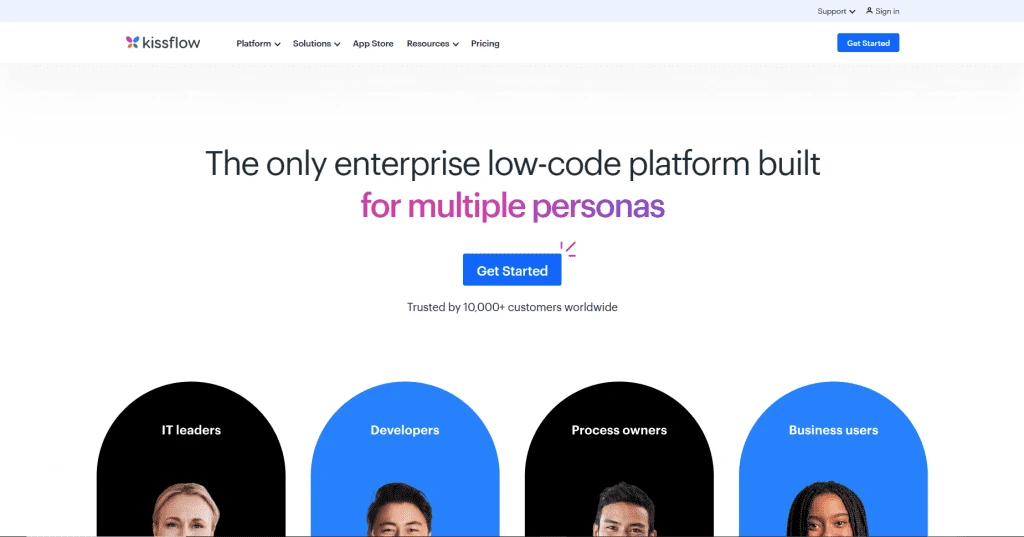
This platform for developing low code applications describes itself as a “Unified Digital Workplace.”. A rule-based paradigm eliminates the requirement for custom coding and enables process customization by enabling you to add scenarios. Since it is a fundamental component of low code development, Kissflow thrives on it. Its major objective is to assist you in managing your workflow and processes.
Kissflow Pricing:
- Small business of 20 to 100 employees- $15 per user per month, billed annually.
- Corporate for 100 to 500 employees- $20 per user per month, billed annually
- Enterprise with more than 500 employees- Get a custom quote based-on number of apps, users, and usage.
Rating

Target Group
It caters to both non-technical users and IT professionals looking for a user-friendly and agile solution for digital transformation and process automation.
Use Case
- Workflow automation for approvals, reviews, and document management.
- HR processes, including employee onboarding and leave requests.
- IT service desk ticketing and incident management.
- Purchase requisitions and procurement processes.
- Project management and task tracking.
- Customer onboarding and support ticketing.
- Compliance and audit processes.
- Vendor management and contract approval.
- Change management and release processes.
Kissflow Features:
- Reporting and analytics for real-time insights.
- Collaboration tools for efficient teamwork.
- Mobile app support for on-the-go access.
- You can digitize your requests and forms.
- Customizable forms and UI components.
- Role-based access control for data security.
- Scalable architecture to handle growing needs.
- Cloud-based deployment for flexibility and accessibility.
- API integration for extended functionality
Kissflow Pros & Cons:
| Pros | Cons |
| Prebuilt Templates and Forms | Limited Offline Capabilities |
| Easily Connects with Third-Party Tools | Vendor Lock-in Due to Proprietary Platform |
| Provide Real-Time Insights | Licensing Costs May Increases for Extensive Usage. |
| Role-Based Access Control | Dependency on Third-Party Integration |
| Flexibility & Accessibility with Cloud Hosting | Complexity in Managing Large Projects |
Looking to develop a new software at reasonable costs and worry less about choosing the right platform? Then, choose our offshore services.
6. Nintex

Next in our list of low code development platforms is Nintex. It is the best low code development platform that empowers businesses to automate, streamline, and optimize their processes and workflows. It is business process management software connected with Office 365, Salesforce, Google Drive, and SharePoint. Since 2018, with two company acquisitions, Nintex has expanded into the business process mapping and robotic process automation areas.
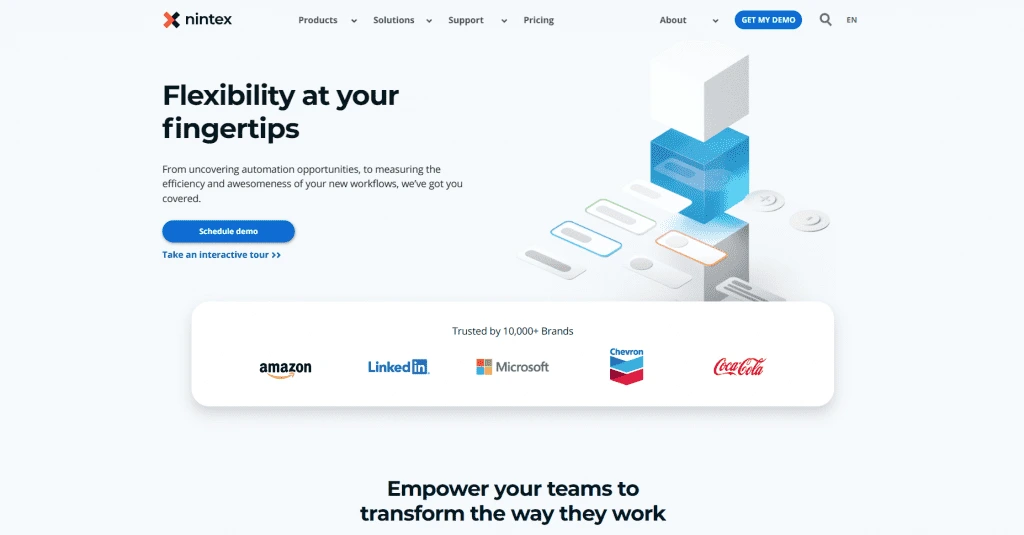
Nintex provides a wide range of automation capabilities, including process mapping, document generation, and data integration, enabling organizations to enhance productivity and collaboration. It offers robust solutions for process management, document generation, digital forms, and mobile app development, making it a versatile tool for driving digital transformation and achieving operational efficiency.
Nintex Pricing:
- Pro Model- Unlimited users, Unlimited workflows, 2,000 document generations Starting -$25,000USD/year
- Premium Model- Unlimited users, Unlimited workflows, 1,000 document generations Starting -$50,000USD/year
- Custom Model- Unlimited users, Unlimited workflows, Customized document generations- Get a quote
Rating
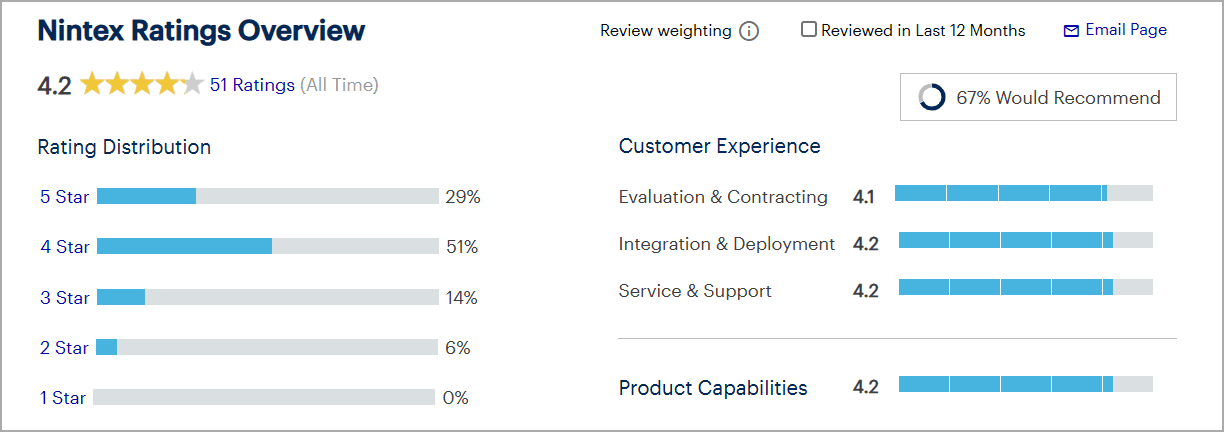
Target Group
- Enterprises of all sizes
- Business and IT professionals
- Organizations across industries
- Dedicated software development teams looking to automate and optimize processes
- Those seeking to streamline workflows and increase productivity with low-code solutions.
Use Case
- Workflow automation for HR processes, such as employee onboarding and leave requests.
- Document generation and management for streamlined documentation processes.
- Digital forms and approval workflows for faster and more efficient data collection.
- Mobile app development for on-the-go access to critical business processes.
- Process mapping and optimization for improved operational efficiency.
Nintex Features:
- This platform has comprehensive workflow, process mapping, and management features.
- It offers process mapping and optimization for improved efficiency.
- Automating, orchestrating, and optimizing business operations using clicks rather than code is quicker and simpler than ever.
- Enterprises can create, implement, and manage the finest solutions and services using Nintex to meet client needs and increase productivity.
- Scalable architecture to accommodate growing business needs.
Nintex Pros & Cons:
| Pros | Cons |
| Easy Document Generation & Management | Possible Cost Implications for Extensive Usage |
| Governance And Compliance Features | Occasional Limitations in Handling Large Datasets |
| Vendor-Supported Training and Resources | May Require IT Support for Certain Advanced Features |
| Extensive Use-Case Library | Delay in Receiving Product Updates |
| Strong Security Measures | Difficult to Manage extensive workflows |
7. Microsoft Power Apps

One of the most used players in the low code development platforms market with the fastest growth rate is Microsoft Power Platform, a new cloud-based platform. Business users can create user interfaces, operational workflows, and data models using Microsoft Power Platform and then deploy them in Microsoft’s Azure cloud. The four Microsoft Power platform offerings are- Power BI, Power Apps, Power Automate, and Power Virtual Agents.

You may quickly and simply design unique business apps using this low code application development platform. The service has outstanding functionality because it has pre-made artificial intelligence components. Another appealing feature is extensibility, which offers over 200 interfaces for combining disparate data and systems.
Microsoft Power Apps Pricing:
- Free for 30 days: Give it a try.
- Plans for subscriptions: $5 per user/app/month for a per app plan, or $20 per user/month for a per user plan.
- Pay-as-you-go strategy: $10 per active user/app/month for the per app plan.
Rating
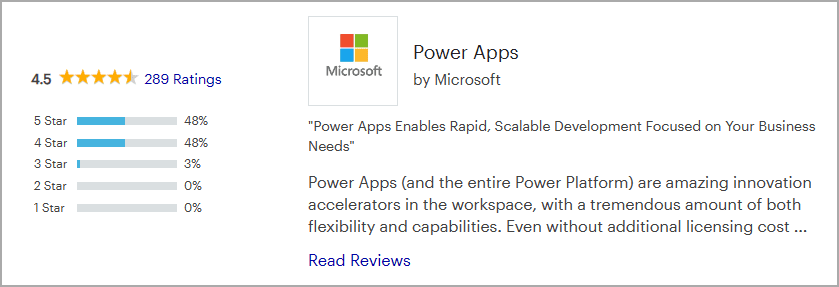
Target Group
The target group of Microsoft Power Apps includes business professionals and developers looking to build custom web applications and automate processes without extensive coding.
Use Case
- Custom business applications tailored to specific needs.
- Workflow automation and process optimization.
- Customer relationship management (CRM) solutions.
- Inventory management and tracking systems.
- Employee onboarding and HR processes.
- Field service management and work order tracking.
- Financial services applications for banking and accounting.
- IoT and connected devices integration for data visualization.
Microsoft Power Apps Features:
- Using a point-and-click method for app design.
- Application to data connection is simple.
- You will be able to develop web-based applications for tablets and smartphones running iOS, Android, and Windows.
- Quickly create solutions with Power Apps and Azure services.
- Utilize Microsoft Dataverse to connect to hundreds of data sources.
- Utilizing GitHub and Azure DevOps, build, validate, and deploy your apps iteratively.
- Safeguard your data with a solid security management architecture.
Microsoft Power Apps Pros & Cons:
| Pros | Cons |
| Seamless Integration with Microsoft 365 | Dependency on third-party connectors for certain features |
| AI Builder for Advanced Data Analysis | Vendor lock-in due to reliance on the Microsoft ecosystem |
| Pre-Built Templates and Connectors | Offline capabilities are limited and require planning |
| Cross-platform support (web, mobile, tablet) | Limited access to underlying code for customization |
| Scalable architecture for growing businesses | Some features may require premium licenses |
Need expert consulting on Microsoft Power Apps? Get our dedicated service now.
8. XPODA

XPODA is also included in the list of the best low-code platforms that empower businesses to build custom applications rapidly and efficiently. With its intuitive visual interface and drag-and-drop components, users can design and deploy apps without extensive coding. XPODA offers many pre-built templates and modules, streamlining the development process.
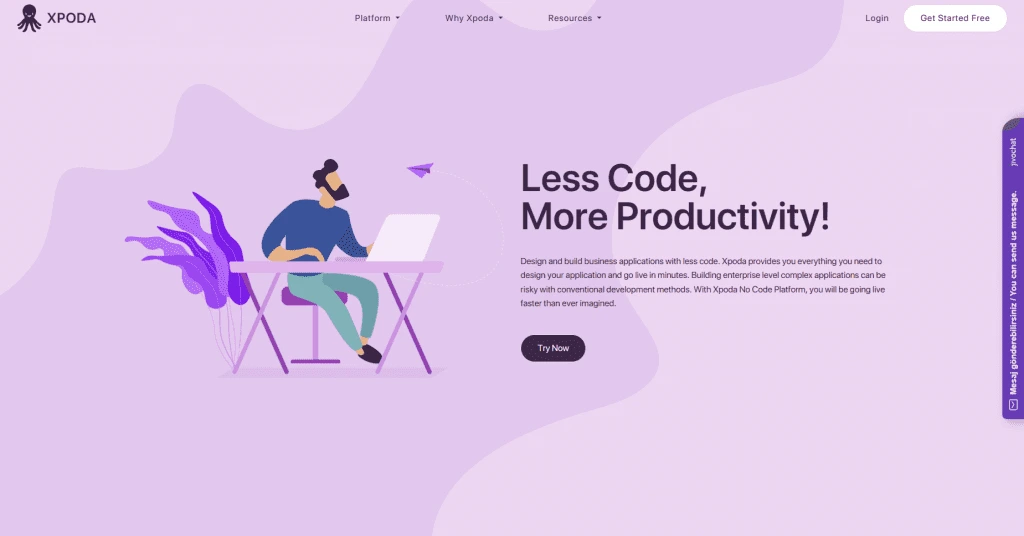
This low code app development platform was created specifically to help you manage back-office tasks and customer relationships (CRM). XPODA enables organizations to optimize processes and improve productivity. Its scalable architecture and cloud-based deployment options suit businesses of all sizes seeking to drive digital transformation and innovation.
XPODA Pricing:
- Free trial is available for 30 days
- Professional package starts at $19 per month per user
- Enterprise package that is a tailor-made platform for your company provides access to unlimited users- Get Quote
Rating

Target Group
Industries, including finance, healthcare, retail, manufacturing, government, and education, to build custom applications and automate processes efficiently without extensive coding.
Use Case
- Automating document collection and form-filling tasks.
- Streamlining task assignments and progress tracking.
- Integrating with existing HR systems and data sources.
- Automating employee onboarding process for HR departments.
- Designing a custom onboarding app with a visual interface.
- Ensuring a seamless onboarding experience for new hires.
- Improving efficiency and data accuracy in HR processes.
XPODA Features:
- Intuitive visual interface for easy app development.
- Pre-built templates and modules for efficient design.
- Seamless integration with various databases and systems.
- Workflow automation for streamlined processes.
- Scalable architecture for growing business needs.
- Cloud-based deployment for flexibility and accessibility.
- Collaboration tools for efficient teamwork.
- Customizable forms and user interfaces.
- Mobile app support for on-the-go access.
XPODA Pros & Cons:
| Pros | Cons |
| Workflow Automation Coding | Offline Capabilities are Limited |
| Seamless Integration with Databases & Systems | Licensing Costs May Increase for Extensive Usage |
| Cloud Based Deployment | Some Advanced Features May Require Custom Coding |
| Customizable Forms & User Interfaces | Limited access to underlying code for customization |
| Scalable architecture for growing businesses | Support Responsiveness Can Vary |
9. Quickbase

Next in our list of low code development platforms is Quickbase. With QuickBase, your team can work on projects of any complexity. It allows individuals without programming skills to collaborate safely and sustainably. Through its application platform, which includes forms, tailored conversations, advances, and procedure automation, the platform targets a wide range of corporate use cases.

QuickBase allows groups to work together on a shared data repository to develop forms, execute reports, set up workflows, and automate procedures. This program’s low-code capability enables non-developers to rapidly and simply create apps without the need for IT support.
Quickbase Pricing:
- Free access for 30 days
- Team plan starts at $35 per user per month
- Business plan starts at $ 55 per user per month
- Enterprise plan is fully customized- Quickbase Pricing
Rating

Target Group
Small and medium-sized businesses, large enterprises, and dedicated developers.
Use Case
- Project management and task tracking.
- CRM solutions for customer relationship management.
- Inventory management and order processing.
- HR processes, including employee onboarding and performance management.
- Workflow automation and approval processes.
- Customer support ticketing and case management.
- Sales pipeline and lead management.
- Data visualization and reporting dashboards.
Quickbase Features:
- Quick Base provides a thorough regulatory compliance and security program that complies with several requirements.
- It provides seamless integration with various data sources and systems.
- Set the limits within which businesses can take control of their operations without endangering the system’s integrity.
- It provides easy access to reporting and analytics for real-time insights.
- Flexible APIs may be connected to your CRM, ERP, PLM, and other core applications to automate the processes those platforms cannot.
Quickbase Pros & Cons:
| Pros | Cons |
| Wide Range of Integration | Dependency on Third-Party Integrations for Certain Features. |
| Intuitive Interface for Quick App Development | Limited Learning Resources |
| Sandbox to Test the Changes | Licensing Cost Increases for Extensive Usage |
| HIPAA and FDA Compliance | Vendor Lock-in Due to Proprietary Platform. |
| Pre-Built Templates for Efficiency | Support Responsiveness Can Vary |
10. Salesforce Lightning

Last in our list of low code development platforms is Salesforce Lightning. A framework that enables non-developers to construct business user interfaces and workflows on Salesforce. Salesforce Lightning is for Salesforce CRM users who wish to create their own user experiences and support desktop, tablet, and mobile devices without writing any code, in contrast to prior low code development platform offerings that let you deploy custom web applications on any public cloud or premises.
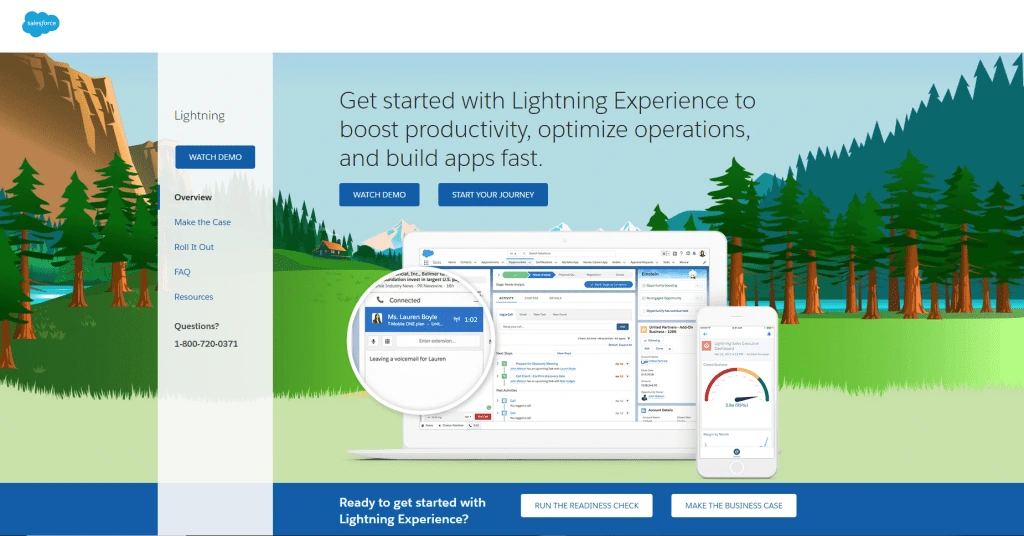
You can create enterprise apps quickly with the Salesforce Platform, which supports employee engagement, customer happiness, performance monitoring, and thorough integration. Force, Heroku, and Lightning are just a few of the tools and services that make up the Salesforce Platform, which enables companies to create and deploy unique online applications swiftly.
Salesforce Lightning Pricing
- Starter Plan- Start fast with sales, service, and email outreach tools ($25 per user per month, billed annually)
- Professional Plan- Complete CRM for any size team ($75 per user per month, billed annually)
- Enterprise Plan- Deeply customizable sales CRM for your business ($300 per user per month, billed annually.
- Unlimited Plan- The ultimate platform for growth ($150 per user per month, billed annually)
Rating

Target Group
The target industries for Salesforce low-code platform include sales, marketing, customer service, finance, healthcare, and retail, among others, seeking streamlined application development and automation for various processes.
Use Case
- Customer relationship management (CRM)
- Sales pipeline management
- Lead generation and tracking
- Case management and customer support
- Marketing automation.
Salesforce Lightning Features:
- Build, test, and deploy changes with assurance.
- Use Salesforce Genie Customer Data Cloud to connect systems, automate processes, and empower people.
- Utilize Shield’s built-in features to safeguard your company.
- You may grow internationally while delivering local customer service using security, privacy, and agility.
- Utilize AI to improve client experiences and spur growth.
- Lightning Process Builder can be used to construct intricate workflows.
Salesforce Lightning Pros & Cons:
| Pros | Cons |
| Easy Integration with Other Salesforce Products and Third-Party Applications. | Dependencies on Salesforce Ecosystem Restrict Transition to Other Platforms. |
| Ready-to-use Templates and Components Speed up Development. | Large-scale or Data-Intensive Apps Could Experience Performance Challenges. |
| Ensures Data Protection and Compliance with Industry Standards. | Complex Workflows May Require Custom Coding Beyond the Low-Code Capabilities. |
| Active User Community and Resources for Problem-Solving. | Relying on Third-Party Integrations Might Lead to Potential Disruptions. |
| Faster App Creation Reduces Time-to-Market | The quality of Customer Support May Vary Based on the Plan and Vendor Policies. |
Equip your team with transformative Power Apps solutions. Let’s unlock the future of your business!
Quick Tips to Enhance Low Code Mobile App Development
Using ergonomic low code development platforms makes it easier to develop apps that generate high ROI.
Here are some of the best practices that you can follow to refine your development process using low code platforms:
- Immaculate Planning: Defining the project’s target audience, functionalities, and scope is crucial. Even if you want to use low code platforms, planning can save time during the development stag
- Use of Pre-built Components: Low-code platforms offer pre-built components like buttons, menus, and forms. You should utilize these elements to save time while maintaining a consistent and exciting look
- Focus on UI/UX: A user-friendly interface is crucial for any app’s success. It is vital to use the low code platform’s design tools to create an intuitive and visually appealing user experience
- Seamless Integration: Many low-code platforms allow integration with external systems and data sources. This approach can expand your software’s functionality and connect it to existing workflows
These tactics can boost the output through a well-planned low code mobile app development process. So, ensure you follow these tips and elevate your end product profoundly.
Low Code vs Traditional Code Development Comparison
| Feature | Low-Code Development | Traditional Code Development |
| Coding Expertise | Lower barrier to entry, often requires minimal coding knowledge. | Requires strong programming skills in specific languages. |
| Development Speed | Faster development due to pre-built components and drag-and-drop tools. | Slower development as applications are built from scratch. |
| Development Team | Can be built by citizen developers or business users with some training. | Requires a dedicated team of experienced software developers. |
| Customization | Limited customization options due to reliance on pre-built components. | Highly customizable with full control over the codebase. |
| Scalability | May have limitations in scalability for highly complex applications. | Highly scalable for large and complex applications. |
| Cost | Potentially lower overall cost due to faster development and reduced resources. | Potentially higher cost due to developer salaries and longer timelines. |
| Security | Built-in security features provided by the platform, but limited control. | Requires robust security measures implemented by developers. |
| Maintenance | Platforms handle most updates and maintenance for basic functionality. | Requires ongoing maintenance and updates by developers. |
| Learning Curve | Easier to learn due to visual tools and pre-built components. | Steeper learning curve requiring mastery of programming languages. Conclusion: Low Code Development Platforms |
What is the Future of Low Code?
The future of low-code development looks bright, with predictions of continued growth and increasing sophistication.
Here are some trends to watch:
1. Rise of the Citizen Developer
Low-code platforms will become even easier to use, empowering more citizen developers to build applications that address their specific needs. This democratization of development will accelerate innovation across organizations.
2. Enhanced AI Integration
Artificial intelligence (AI) will play a bigger role in low-code platforms. AI can automate repetitive tasks, suggest intelligent workflows, and even generate code based on user requirements
3. Improved Scalability and Security
Low-code platforms will address current limitations in scalability and security. We can expect platforms capable of handling complex enterprise applications while offering robust security features and granular access control.
4. Hybrid Development Approach
A hybrid approach combining low-code with traditional coding will likely become the norm. Low-code will be used for rapid development of core functionalities, while traditional coding remains crucial for complex integrations and unique customizations.
Overall, low-code development is poised to transform the way applications are built, making it faster, more accessible, and adaptable to the ever-changing needs of businesses.
Conclusion: Low Code Development Platforms
The low code development platforms are an economic windfall in this fast-paced environment with ever-increasing competition. These low code development platforms shorten the time to market and encourage all enterprises, regardless of size, to turn their vision into reality quickly. The top 10 low-code platforms listed above are a great place to start if you want to digitally revolutionize your company’s operations.
Although none of these platforms require technical knowledge, seeking professional guidance when creating an innovative application to stand out from the crowd is still advisable.
We at eLuminous Technologies can help you in this regard. Being in the web and mobile app development industry since 2002, we have gained a lot of experience in developing digital products of any complexity and customizing them in within your budget.
Let’s connect to learn more about our offerings.
Your vision deserves expert guidance. Let’s make it a reality together. Reach out to us now!
Frequently Asked Questions: Low Code Development Platforms
What are Low Code Development Platforms?
Low-code platforms are development tools that enable users to create applications with minimal hand-coding, using visual interfaces and pre-built components. They accelerate application development, streamline workflows, and empower non-technical users to build custom solutions quickly and efficiently.
How to Choose the Best Low Code Development Platforms?
To choose the best low code development platform, consider factors such as scalability, ease of use, integration capabilities, available templates, security features, pricing, and support.
Assess your project requirements, team expertise, and desired outcomes to find a platform that aligns with your business needs and goals for rapid and efficient application development.
Can I develop applications using these platforms, or do I need to hire developers?
You can develop applications using low-code platforms without extensive coding knowledge. These platforms are designed to empower business professionals and non-developers to create applications.
However, hiring dedicated developers may be necessary for more complex projects or specific customizations. Developers can enhance the application with advanced features, integrations, and code modifications, complementing the capabilities of low-code platforms and ensuring the best outcome for your specific requirements.

